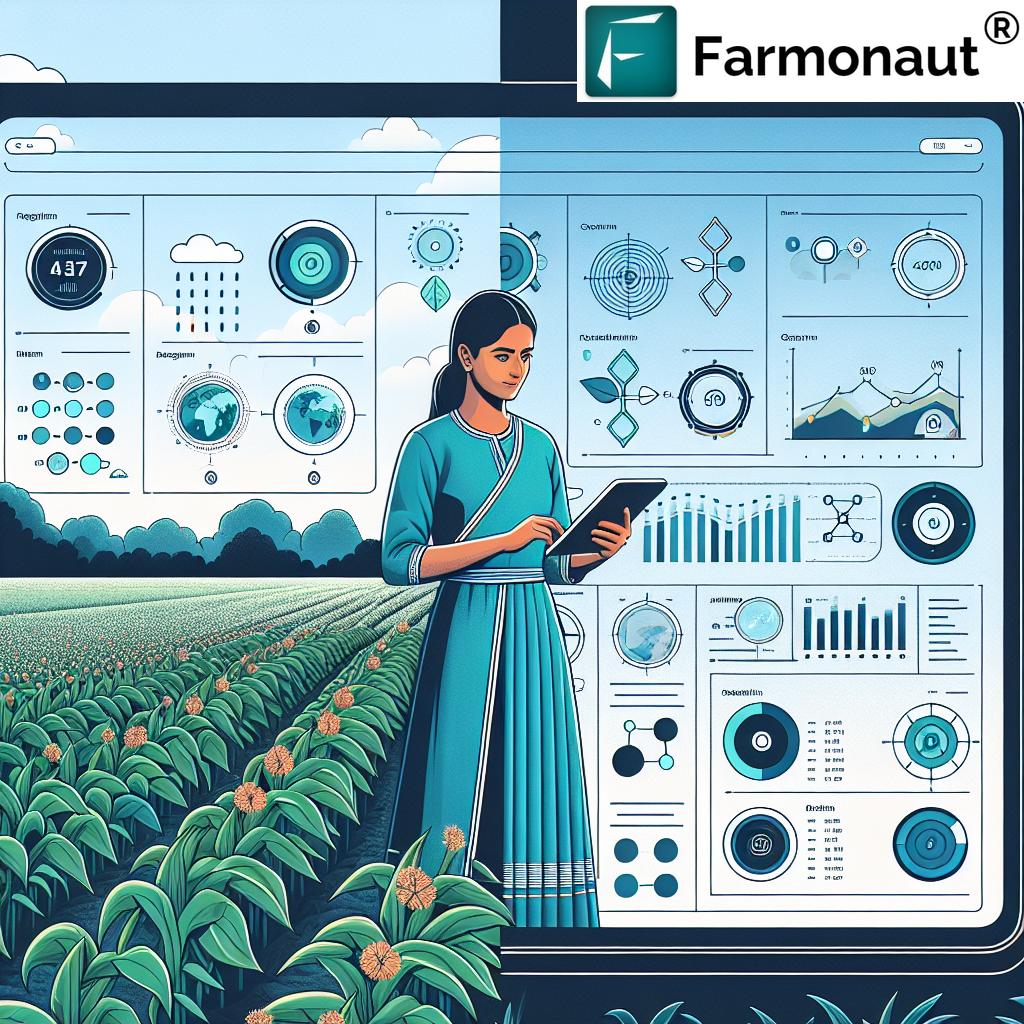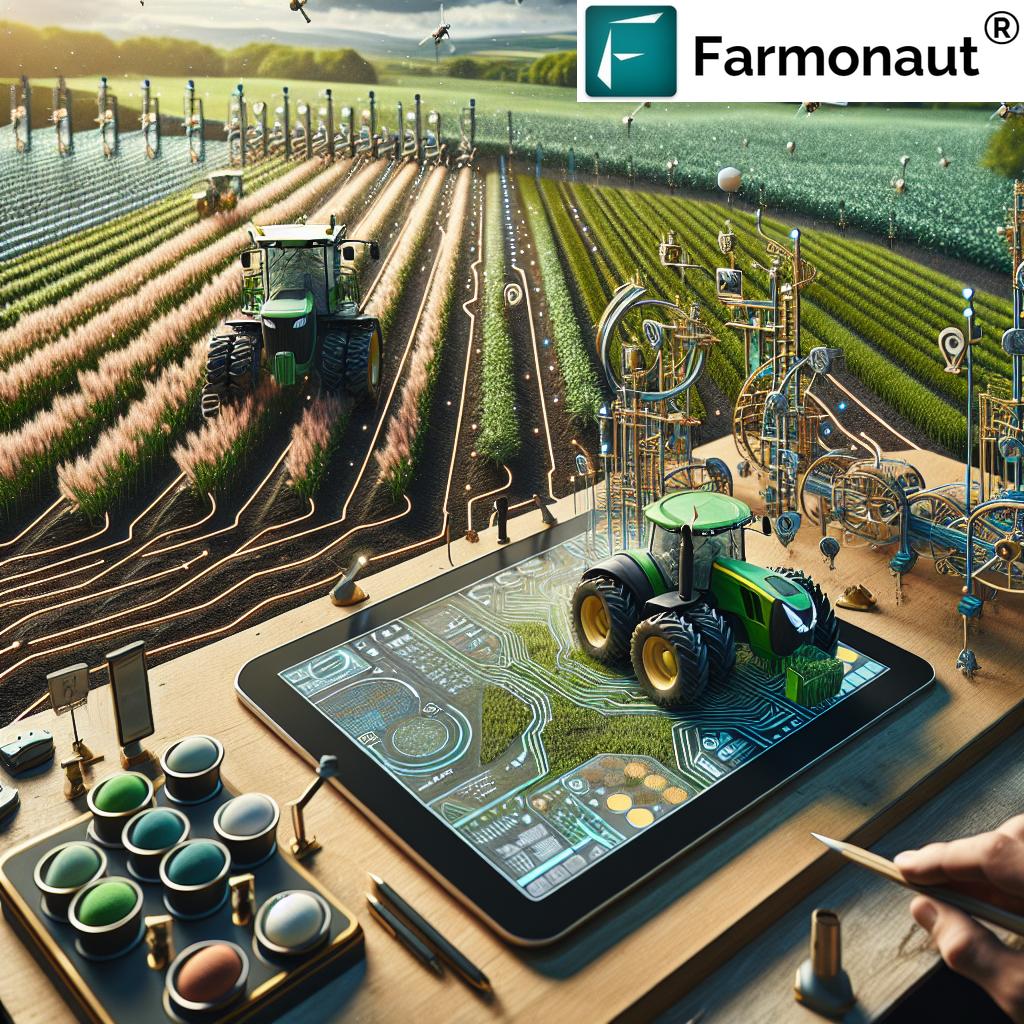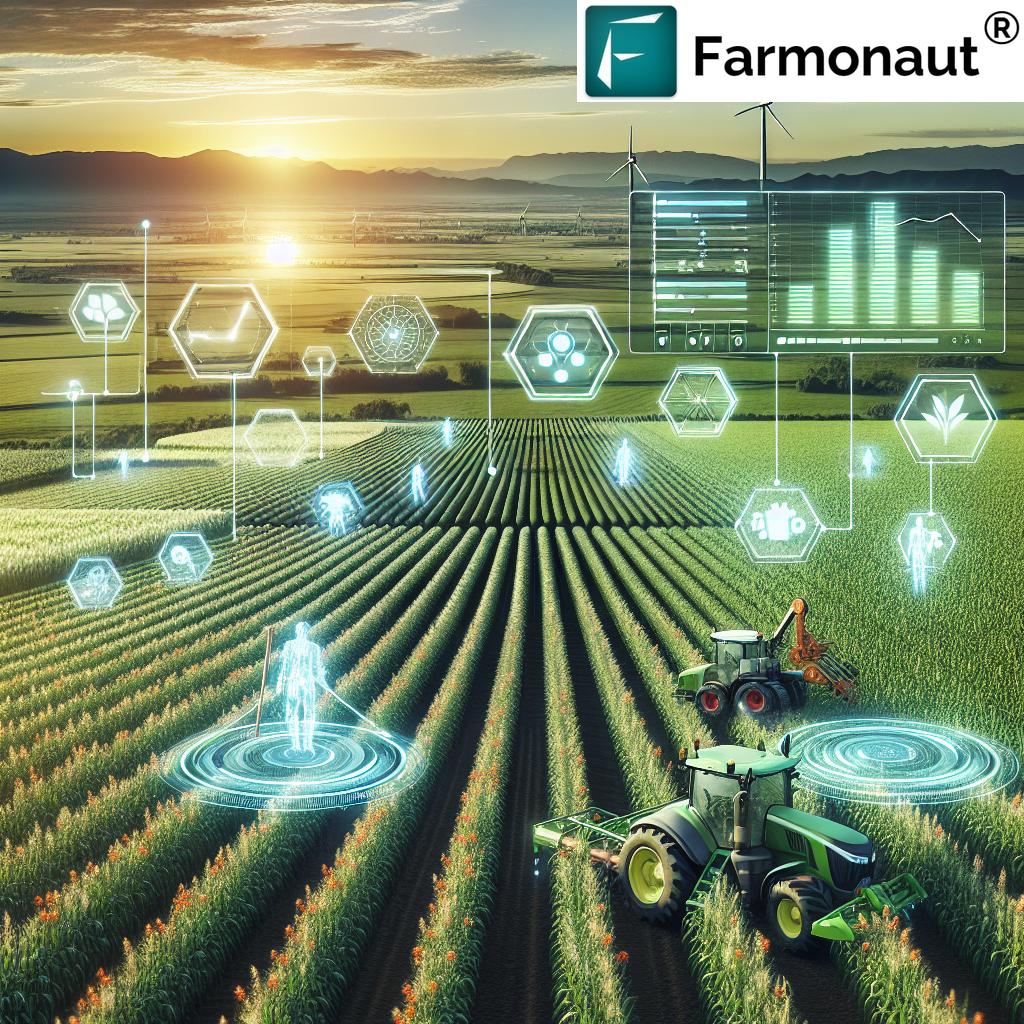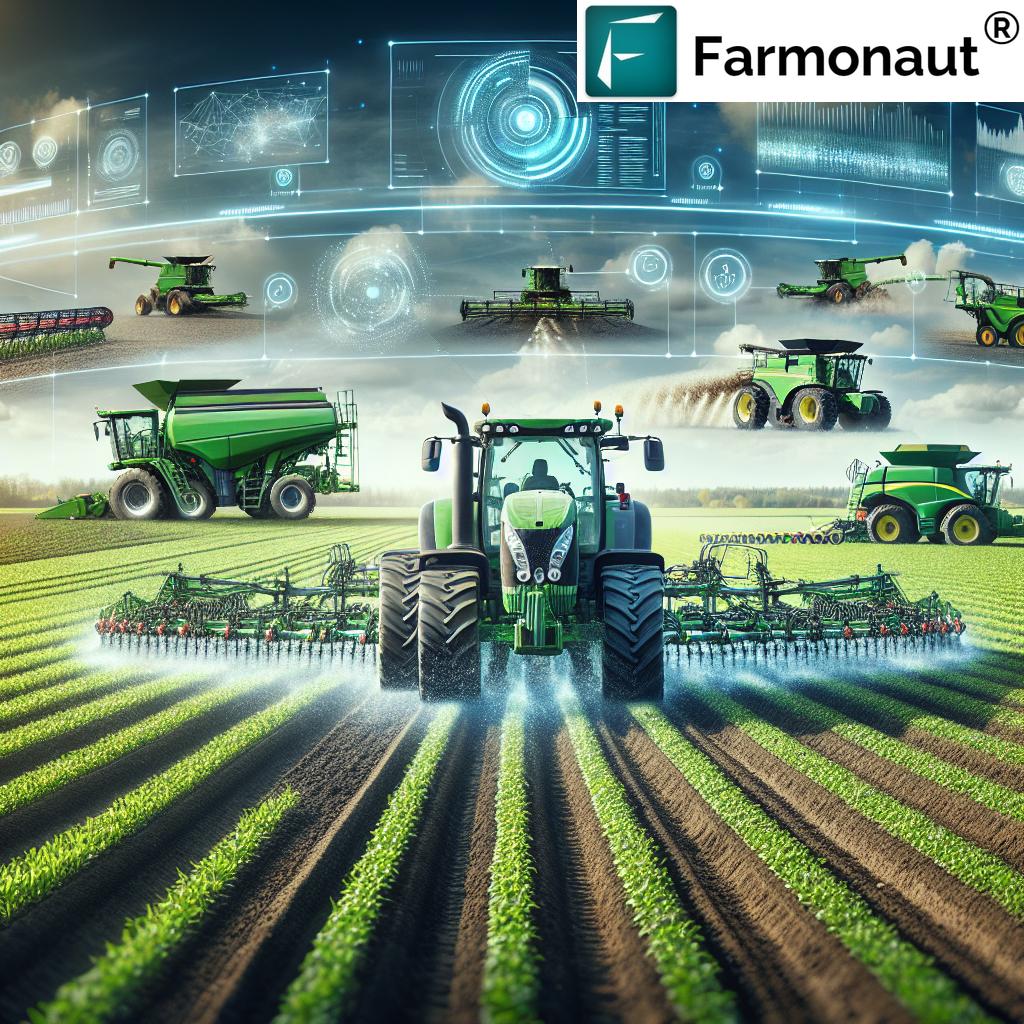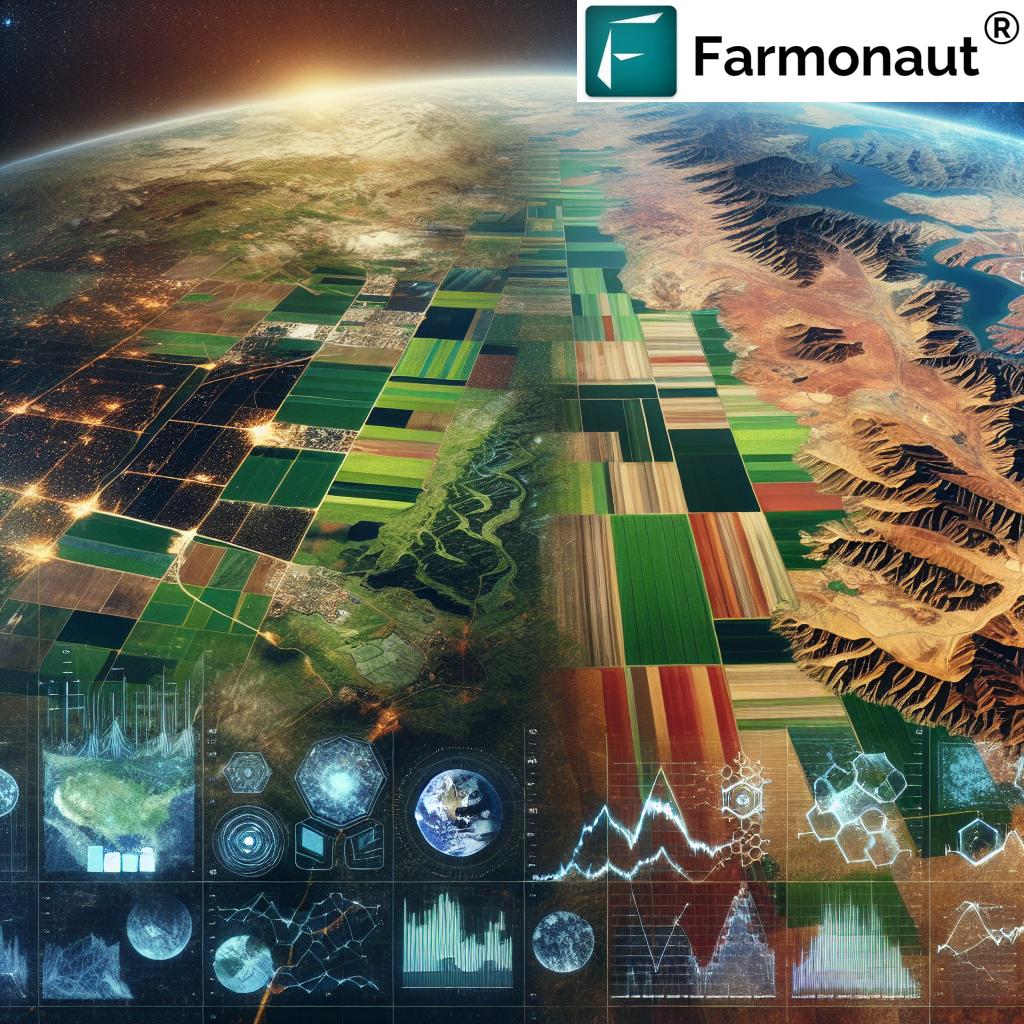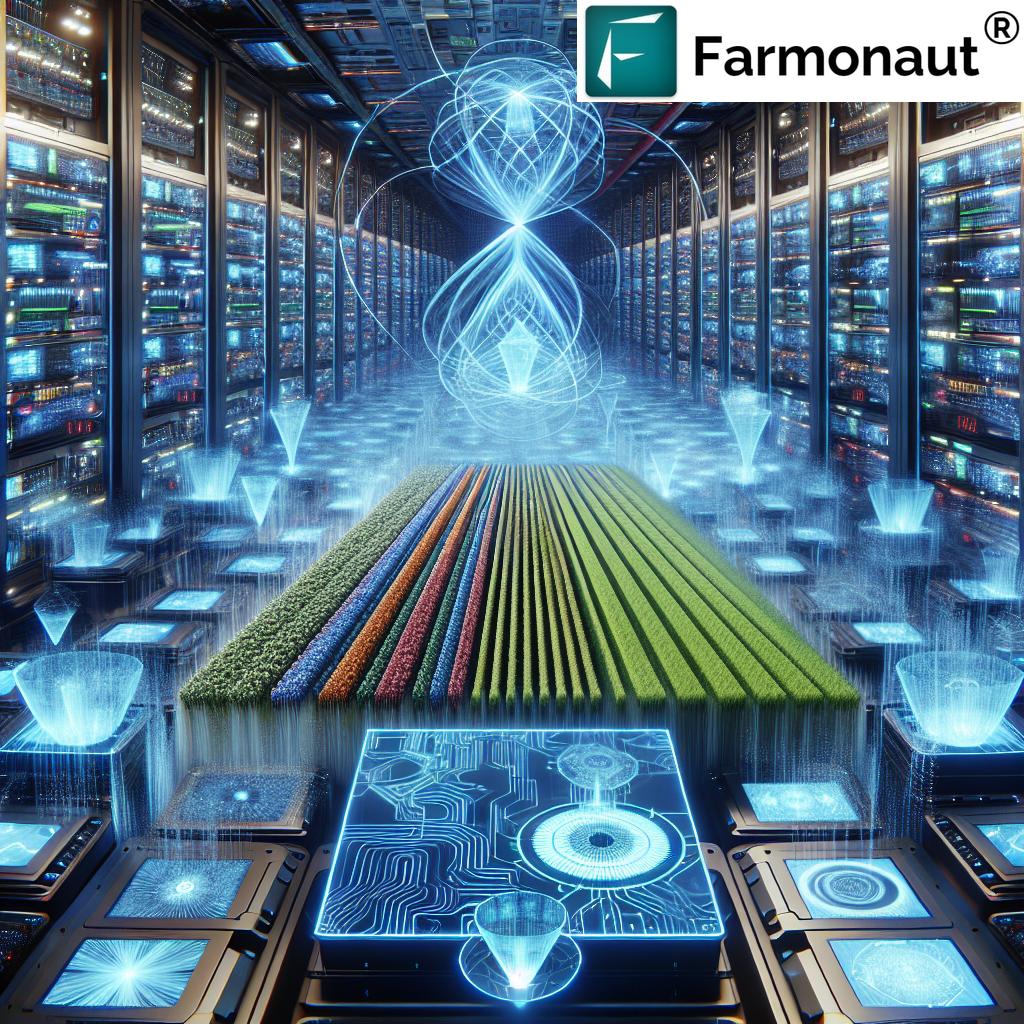Revolutionizing Agriculture: Precision Farming with Satellite Imagery, GIS, and AI-Driven Crop Monitoring for Sustainable Yield Prediction
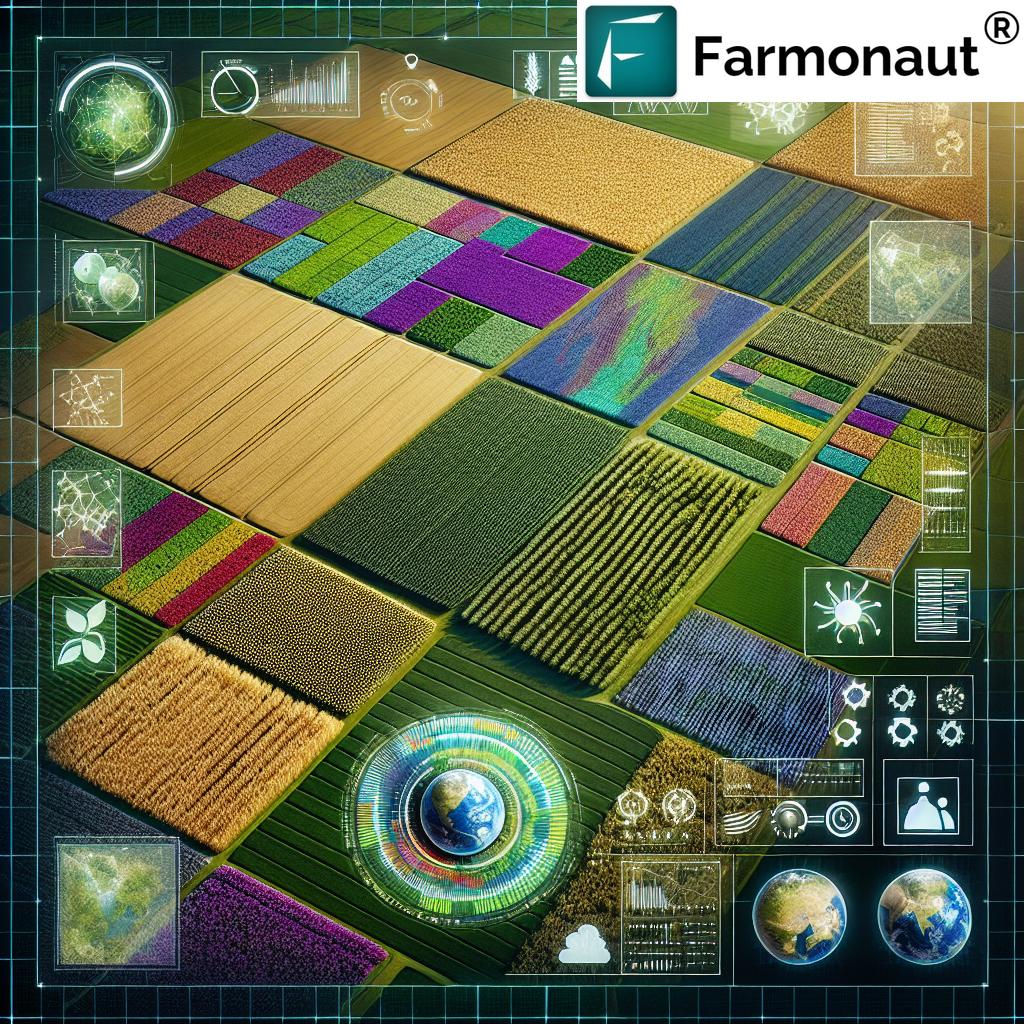
In today’s rapidly evolving agricultural landscape, we find ourselves at the forefront of a technological revolution that is transforming the way we approach farming. The integration of satellite imagery, Geographic Information Systems (GIS), and Artificial Intelligence (AI) into agricultural practices has opened up new horizons for precision farming, sustainable crop management, and accurate yield prediction. At Farmonaut, we are proud to be at the vanguard of this agricultural transformation, offering cutting-edge solutions that empower farmers and agribusinesses to make data-driven decisions and optimize their operations.
The Evolution of Agricultural Monitoring
Traditional farming methods have long relied on manual observation and historical knowledge passed down through generations. While these practices have served us well, they are often limited in scope and accuracy. The advent of advanced technologies has ushered in a new era of agricultural monitoring that promises to revolutionize the industry.
Satellite Imagery: A Bird’s Eye View of Crop Health
One of the most significant advancements in agricultural monitoring is the use of satellite imagery. High-resolution satellite images provide us with a comprehensive view of vast agricultural lands, allowing for real-time monitoring of crop health and development. These images capture various spectral bands, including visible light and near-infrared, which are crucial for assessing vegetation health.
- Normalized Difference Vegetation Index (NDVI): By analyzing the reflectance of red and near-infrared light, we can calculate the NDVI, a key indicator of plant health and vigor.
- Multispectral Analysis: Advanced satellite sensors capture data across multiple spectral bands, enabling the detection of subtle changes in crop health that may not be visible to the naked eye.
- Temporal Monitoring: Regular satellite passes allow for consistent monitoring of crop growth patterns over time, facilitating early detection of issues and timely interventions.
GIS: Mapping Agricultural Landscapes
Geographic Information Systems (GIS) play a crucial role in modern agricultural monitoring by integrating various spatial data sources and providing powerful analytical tools. GIS allows us to create detailed maps of agricultural fields, incorporating information on soil types, topography, and historical yield data.
- Spatial Analysis: GIS enables the identification of spatial patterns and relationships within agricultural data, helping to optimize field management strategies.
- Data Layering: Multiple data layers can be overlaid to provide a comprehensive view of field conditions, including soil moisture, nutrient levels, and pest infestations.
- Precision Agriculture: GIS supports variable rate application (VRA) of inputs such as fertilizers and pesticides, ensuring optimal resource utilization and reducing environmental impact.
AI and Machine Learning: Intelligent Crop Analysis
The integration of Artificial Intelligence and Machine Learning algorithms into agricultural monitoring systems has dramatically enhanced our ability to interpret and act upon the vast amounts of data collected through satellite imagery and ground-based sensors.
- Crop Classification: AI algorithms can accurately identify and classify different crop types and growth stages from satellite imagery, enabling large-scale crop mapping and monitoring.
- Yield Prediction: Machine learning models analyze historical data, current crop conditions, and weather forecasts to provide accurate yield predictions, helping farmers and agribusinesses make informed decisions.
- Anomaly Detection: AI-powered systems can quickly identify anomalies in crop health, such as pest infestations or disease outbreaks, allowing for rapid response and mitigation.
Soil Management: The Foundation of Sustainable Agriculture
Effective soil management is crucial for maintaining long-term agricultural productivity and sustainability. Advanced monitoring technologies have revolutionized our approach to soil management, providing unprecedented insights into soil health and fertility.
Remote Sensing for Soil Analysis
Remote sensing technologies, including satellite imagery and aerial surveys, offer valuable data on soil properties and conditions across large areas.
- Soil Moisture Monitoring: Microwave sensors on satellites can penetrate the soil surface to measure moisture content, helping optimize irrigation practices and prevent water stress in crops.
- Soil Composition Analysis: Hyperspectral imaging can provide information on soil organic matter content, texture, and mineral composition, guiding fertilization and amendment strategies.
- Erosion Risk Assessment: By analyzing topography and vegetation cover, we can identify areas at risk of soil erosion and implement targeted conservation measures.
Precision Soil Sampling and Mapping
Combining remote sensing data with ground-based soil sampling allows for the creation of highly accurate soil maps that guide precision agriculture practices.
- Grid Sampling: Systematic soil sampling based on a grid pattern provides detailed information on soil variability within fields.
- Zone Management: Fields can be divided into management zones based on soil properties, allowing for tailored application of inputs and management practices.
- Temporal Analysis: Regular soil sampling and mapping enable the tracking of soil health trends over time, informing long-term management strategies.
Data-Driven Farming: Harnessing the Power of Agricultural Intelligence
The abundance of data generated by modern agricultural monitoring systems has given rise to a new paradigm of data-driven farming. This approach leverages advanced analytics and machine learning to extract actionable insights from complex datasets, empowering farmers and agribusinesses to make informed decisions.
Big Data in Agriculture
The agricultural sector is experiencing a data revolution, with vast amounts of information being collected from various sources:
- Satellite and Aerial Imagery: Regular captures of high-resolution imagery provide a wealth of data on crop health, growth patterns, and field conditions.
- IoT Sensors: Networks of Internet of Things (IoT) sensors deployed in fields collect real-time data on soil moisture, temperature, humidity, and other environmental factors.
- Weather Stations: Local and regional weather data provide crucial information for crop management and yield prediction.
- Machinery Telemetry: Modern agricultural machinery equipped with GPS and sensors generates valuable data on field operations and productivity.
Advanced Analytics for Agricultural Insights
The true value of agricultural data lies in our ability to analyze and interpret it effectively. Advanced analytics techniques allow us to uncover patterns, trends, and correlations that inform strategic decision-making:
- Predictive Analytics: By analyzing historical data and current conditions, we can forecast crop yields, pest outbreaks, and market trends with increasing accuracy.
- Prescriptive Analytics: AI-driven systems can provide specific recommendations for crop management, such as optimal planting dates, irrigation schedules, and fertilizer applications.
- Risk Assessment: Data analytics help identify potential risks to crop production, enabling proactive risk management strategies.
The Role of Machine Learning in Agriculture
Machine learning algorithms are revolutionizing the way we process and interpret agricultural data:
- Image Recognition: Deep learning models can analyze satellite and drone imagery to detect crop diseases, weed infestations, and nutrient deficiencies with high accuracy.
- Crop Modeling: Machine learning algorithms can simulate crop growth under various environmental conditions, helping optimize management practices and predict yields.
- Automated Decision Support: AI-powered systems can provide real-time recommendations to farmers, taking into account multiple factors such as weather forecasts, market conditions, and resource availability.
Precision Agriculture: Maximizing Efficiency and Sustainability
Precision agriculture represents a paradigm shift in farming practices, leveraging technology to optimize resource use and maximize productivity while minimizing environmental impact. At the heart of precision agriculture lies the concept of site-specific management, tailoring farming practices to the unique conditions of each part of a field.
Variable Rate Technology (VRT)
Variable Rate Technology is a cornerstone of precision agriculture, allowing for the precise application of inputs based on spatial variability within fields:
- Variable Rate Fertilization: By mapping soil nutrient levels and crop needs, fertilizers can be applied at varying rates across a field, ensuring optimal nutrition while reducing waste and environmental impact.
- Precision Irrigation: VRT irrigation systems adjust water application rates based on soil moisture levels, crop water requirements, and local topography, conserving water resources and preventing over-irrigation.
- Targeted Pest Management: Precision spraying technologies allow for the application of pesticides only where needed, reducing chemical use and preserving beneficial insects.
Automated Guidance Systems
GPS-guided machinery and automated steering systems have revolutionized field operations:
- Reduced Overlap: Precise navigation minimizes overlap in planting, spraying, and harvesting operations, saving time, fuel, and inputs.
- Controlled Traffic Farming: By confining heavy machinery to specific paths, soil compaction is reduced, improving soil health and crop yields.
- 24/7 Operations: Automated guidance enables farming operations to continue in low-visibility conditions, increasing productivity.
Crop Scouting and Monitoring
Advanced technologies have transformed the way we monitor crop health and development:
- Drone-Based Scouting: Unmanned aerial vehicles (UAVs) equipped with multispectral cameras provide high-resolution imagery for detailed crop assessment.
- Satellite Monitoring: Regular satellite passes offer consistent, large-scale monitoring of crop health and development stages.
- IoT Sensor Networks: In-field sensors continuously monitor environmental conditions, providing real-time data on factors affecting crop growth.
Weather Integration: Enhancing Agricultural Decision-Making
Weather plays a crucial role in agricultural productivity, and integrating accurate weather data into farming systems is essential for optimizing operations and mitigating risks. Modern agricultural technologies leverage advanced weather forecasting and historical climate data to improve decision-making at every stage of the crop cycle.
High-Resolution Weather Forecasting
Advancements in meteorological modeling and data assimilation techniques have significantly improved the accuracy and resolution of weather forecasts for agriculture:
- Microclimate Prediction: Localized weather forecasts take into account topography and other factors to provide field-specific predictions.
- Ensemble Forecasting: Multiple model runs provide probabilistic forecasts, helping farmers assess weather-related risks and make informed decisions.
- Seasonal Outlooks: Long-range forecasts aid in crop selection and planning for upcoming growing seasons.
Weather-Based Decision Support Systems
Integrating weather data with crop models and farm management systems enables sophisticated decision support:
- Planting Date Optimization: Historical weather patterns and short-term forecasts help determine the best time to plant crops for optimal emergence and growth.
- Pest and Disease Forecasting: Weather-based models predict the likelihood of pest infestations and disease outbreaks, enabling proactive management.
- Harvest Timing: Weather forecasts inform decisions on the optimal timing for harvest operations, balancing crop maturity with favorable weather conditions.
Climate Change Adaptation
As climate patterns shift, integrating long-term climate data and projections into agricultural planning becomes increasingly important:
- Crop Suitability Mapping: Analysis of changing climate patterns helps identify suitable crops and varieties for specific regions.
- Risk Assessment: Climate projections inform long-term risk management strategies, such as investing in irrigation infrastructure or adopting drought-tolerant crops.
- Carbon Footprint Reduction: Weather-optimized farming practices can contribute to reducing greenhouse gas emissions from agriculture.
Sustainable Agriculture: Balancing Productivity and Environmental Stewardship
As we face the dual challenges of feeding a growing global population and mitigating the environmental impact of agriculture, sustainable farming practices have become more critical than ever. Advanced agricultural technologies play a crucial role in promoting sustainability by optimizing resource use, reducing environmental degradation, and enhancing ecosystem services.
Conservation Agriculture
Conservation agriculture principles, supported by precision farming technologies, help preserve soil health and reduce environmental impact:
- Minimal Soil Disturbance: GPS-guided machinery enables precise no-till or reduced tillage practices, preserving soil structure and organic matter.
- Crop Rotation and Diversification: Advanced crop modeling and market analysis tools help farmers plan optimal crop rotations that improve soil health and break pest cycles.
- Permanent Soil Cover: Remote sensing technologies monitor cover crop growth and residue levels, ensuring adequate soil protection.
Integrated Pest Management (IPM)
Technology-driven IPM strategies reduce reliance on chemical pesticides while effectively managing pests and diseases:
- Early Detection: AI-powered image analysis of satellite and drone imagery can identify pest and disease outbreaks in their early stages.
- Biological Control: GIS mapping of beneficial insect populations helps in planning targeted releases for natural pest control.
- Precision Application: When pesticides are necessary, variable rate technology ensures minimal and targeted application, reducing environmental impact.
Water Conservation
Efficient water management is crucial for sustainable agriculture, especially in water-scarce regions:
- Precision Irrigation: Soil moisture sensors, weather data, and crop water requirement models enable highly efficient irrigation scheduling.
- Drought-Resistant Crop Selection: AI-driven analytics help farmers choose crop varieties best suited to local water availability and climate projections.
- Water Harvesting: GIS tools assist in planning and implementing water harvesting structures to maximize rainwater utilization.
Biodiversity Conservation
Precision agriculture technologies support efforts to maintain biodiversity within agricultural landscapes:
- Habitat Mapping: Remote sensing and GIS tools help identify and protect important wildlife habitats within and around farmlands.
- Pollinator Support: Precision planting of flowering strips and targeted pesticide application help protect and promote pollinator populations.
- Invasive Species Management: Early detection and rapid response systems, powered by AI and remote sensing, help control invasive species that threaten biodiversity.
The Future of Agriculture: Emerging Technologies and Trends
As we look to the future, several emerging technologies and trends promise to further revolutionize the agricultural industry, enhancing productivity, sustainability, and resilience in the face of global challenges.
Artificial Intelligence and Machine Learning
The role of AI and machine learning in agriculture is set to expand dramatically:
- Autonomous Farming: Self-driving tractors and robotic harvesters will become increasingly common, reducing labor requirements and improving efficiency.
- Advanced Crop Modeling: AI-powered crop models will integrate real-time data from multiple sources to provide highly accurate yield predictions and management recommendations.
- Personalized Crop Varieties: Machine learning algorithms will accelerate plant breeding programs, developing crop varieties tailored to specific environments and end-uses.
Internet of Things (IoT) and Edge Computing
The proliferation of IoT devices and edge computing capabilities will transform data collection and processing in agriculture:
- Real-Time Decision Making: Edge computing will enable on-farm processing of sensor data, allowing for instant decision-making and equipment adjustment.
- Swarm Robotics: Networks of small, autonomous robots will work together to perform tasks such as planting, weeding, and harvesting with high precision.
- Predictive Maintenance: IoT sensors on farm machinery will enable predictive maintenance, reducing downtime and improving overall farm efficiency.
Vertical Farming and Controlled Environment Agriculture
As urbanization continues and arable land becomes scarcer, vertical farming and controlled environment agriculture will play an increasingly important role:
- Urban Food Production: Advanced hydroponics and aeroponics systems will enable large-scale food production in urban areas, reducing transportation costs and improving food security.
- Climate-Resilient Agriculture: Controlled environment systems will allow for year-round production of crops in regions with challenging climates.
- Resource Efficiency: Closed-loop systems in vertical farms will maximize water and nutrient use efficiency, minimizing environmental impact.
Blockchain and Traceability
Blockchain technology will revolutionize supply chain management and traceability in agriculture:
- Food Safety: Immutable blockchain records will enable rapid tracing of food products from farm to table, enhancing food safety and recall efficiency.
- Fair Trade: Blockchain-based smart contracts will ensure fair compensation for farmers and transparency throughout the supply chain.
- Carbon Credits: Blockchain systems will facilitate the verification and trading of carbon credits generated through sustainable farming practices.
Gene Editing and Synthetic Biology
Advancements in gene editing technologies like CRISPR and synthetic biology will open new possibilities for crop improvement:
- Climate Resilience: Gene-edited crops with enhanced drought tolerance and heat resistance will help agriculture adapt to changing climates.
- Nutritional Enhancement: Biofortified crops will address nutritional deficiencies in staple foods, improving global health outcomes.
- Pest Resistance: Precise genetic modifications will confer robust pest and disease resistance, reducing the need for chemical pesticides.
Challenges and Considerations in Advanced Agricultural Technologies
While the potential benefits of advanced agricultural technologies are immense, their widespread adoption and effective implementation face several challenges that must be addressed:
Data Privacy and Security
As agriculture becomes increasingly data-driven, concerns about data ownership, privacy, and security come to the forefront:
- Data Ownership: Clear policies and agreements are needed to define who owns and has rights to farm data collected by various technologies.
- Cybersecurity: As farm systems become more connected, robust cybersecurity measures are essential to protect against hacking and data breaches.
- Data Standardization: Developing common data standards and interoperability protocols is crucial for maximizing the value of agricultural data across different platforms and systems.
Digital Divide and Accessibility
Ensuring equitable access to advanced agricultural technologies is essential for preventing a widening gap between large-scale and small-scale farmers:
- Infrastructure Development: Improving rural internet connectivity and digital infrastructure is crucial for enabling smallholder farmers to benefit from precision agriculture technologies.
- Education and Training: Comprehensive training programs are needed to build digital literacy and technical skills among farmers and agricultural workers.
- Affordable Solutions: Developing cost-effective technologies and business models that are accessible to small-scale farmers is essential for widespread adoption.
Environmental and Ethical Considerations
As we embrace new technologies, it’s crucial to consider their broader environmental and ethical implications:
- Biodiversity Impact: The potential effects of gene-edited crops and intensive precision farming on local ecosystems and biodiversity must be carefully studied and monitored.
- Energy Consumption: The energy requirements of data centers, IoT networks, and automated systems need to be balanced with efforts to reduce agriculture’s carbon footprint.
- Socioeconomic Effects: The impact of increasing automation on rural employment and traditional farming communities must be addressed through policy and social programs.
Regulatory Frameworks
Developing appropriate regulatory frameworks is essential for guiding the responsible development and use of agricultural technologies:
- Gene Editing Regulations: Clear and science-based regulations for gene-edited crops are needed to ensure safety while fostering innovation.
- Drone and Autonomous Vehicle Policies: Regulations governing the use of drones and autonomous farm machinery must balance safety concerns with the needs of agricultural operations.
- Data Governance: Comprehensive data governance frameworks are required to address issues of data ownership, privacy, and cross-border data flows in agriculture.
Conclusion: Embracing a Technologically Advanced and Sustainable Agricultural Future
As we stand at the cusp of a new era in agriculture, the integration of advanced technologies such as satellite imagery, GIS, AI, and precision farming tools offers unprecedented opportunities to address the complex challenges facing global food production. These innovations promise to enhance productivity, improve resource efficiency, and promote sustainability in ways that were unimaginable just a few decades ago.
However, realizing the full potential of these technologies requires a concerted effort from all stakeholders in the agricultural ecosystem. Farmers, agribusinesses, technology providers, researchers, and policymakers must work together to overcome the challenges of implementation, ensure equitable access, and address ethical and environmental concerns.
At Farmonaut, we are committed to driving this technological revolution in agriculture forward. Our platform integrates cutting-edge satellite monitoring, AI-driven analytics, and user-friendly interfaces to make advanced agricultural technologies accessible to farmers of all scales. By providing real-time crop health monitoring, personalized advisory services, and powerful data analytics tools, we aim to empower farmers to make informed decisions that optimize their operations and contribute to a more sustainable and productive agricultural future.
As we continue to innovate and expand our services, we invite farmers, agribusinesses, and agricultural professionals to join us in exploring the possibilities of technology-driven agriculture. Together, we can build a future where advanced technologies and sustainable practices work hand in hand to ensure food security, environmental stewardship, and prosperity for farming communities around the world.
Comparison: Farmonaut Satellite System vs. Traditional Farming Methods
| Aspect | Traditional Farming | Farmonaut System |
|---|---|---|
| Crop Monitoring | Manual field scouting, limited frequency | Real-time satellite imagery, AI-driven analysis |
| Soil Management | Periodic soil testing, uniform application | Continuous monitoring, precision variable rate application |
| Yield Prediction | Based on historical data and experience | AI-powered predictive models using multiple data sources |
| Resource Efficiency | Generalized approach, potential overuse | Optimized resource use based on precise field data |
| Data Analytics | Limited, often manual analysis | Advanced analytics integrating multiple data streams |
| Weather Integration | General forecasts, limited application | Field-specific forecasts integrated with management decisions |
| Sustainability | Variable, depends on individual practices | Enhanced through precision management and resource optimization |
Frequently Asked Questions (FAQ)
1. What is precision agriculture, and how does it benefit farmers?
Precision agriculture is an approach that uses advanced technologies like satellite imagery, GPS, and sensors to optimize farming practices. It benefits farmers by improving crop yields, reducing input costs, and promoting sustainable resource use through targeted interventions based on precise field data.
2. How does satellite imagery contribute to crop monitoring?
Satellite imagery provides regular, large-scale views of agricultural lands, capturing data on crop health, growth stages, and field conditions. This information helps farmers detect issues early, make informed decisions, and optimize crop management practices.
3. What role does AI play in modern agriculture?
AI in agriculture analyzes vast amounts of data from various sources to provide insights and predictions. It helps in crop yield forecasting, pest and disease detection, optimizing resource use, and automating farm operations, making farming more efficient and productive.
4. How can small-scale farmers benefit from advanced agricultural technologies?
Small-scale farmers can benefit through affordable, user-friendly platforms that provide access to satellite data, weather forecasts, and agronomic advice. These tools can help improve decision-making, increase yields, and reduce risks without requiring significant upfront investments.
5. What is the importance of soil management in sustainable agriculture?
Effective soil management is crucial for maintaining long-term soil health, productivity, and sustainability. It involves practices that preserve soil structure, enhance nutrient cycling, and promote beneficial soil organisms, all of which contribute to improved crop yields and environmental conservation.
6. How does weather data integration improve farming practices?
Integrating accurate weather data helps farmers make timely decisions on planting, irrigation, pest control, and harvesting. It allows for better risk management, resource optimization, and adaptation to changing climate conditions.
7. What are the main challenges in adopting precision agriculture technologies?
Key challenges include initial costs, technical complexity, data privacy concerns, and the need for training and support. Addressing these issues requires collaboration between technology providers, educational institutions, and policymakers to ensure widespread adoption and benefits.
8. How does Farmonaut’s platform differ from other agricultural technology solutions?
Farmonaut’s platform integrates satellite imagery, AI-driven analytics, and user-friendly interfaces to provide comprehensive farm management solutions. It offers real-time crop monitoring, personalized advisory services, and data analytics tools accessible to farmers of all scales, promoting both productivity and sustainability.
9. What future trends are expected in agricultural technology?
Future trends include increased automation through robotics and AI, expansion of vertical farming and controlled environment agriculture, greater use of gene editing for crop improvement, and the integration of blockchain for supply chain transparency and traceability.
10. How can farmers get started with using advanced agricultural technologies?
Farmers can start by exploring user-friendly platforms like Farmonaut, which offer accessible entry points into precision agriculture. Beginning with basic features like satellite-based crop monitoring and weather integration, farmers can gradually adopt more advanced technologies as they become comfortable with the systems and see tangible benefits.
Ready to revolutionize your farming practices with cutting-edge technology? Visit Farmonaut’s application to get started with our advanced agricultural solutions. For developers interested in integrating our powerful API into their own applications, check out our API documentation.
Download our mobile apps for on-the-go access to your farm data and insights:
- Android: Farmonaut on Google Play
- iOS: Farmonaut on the App Store
For detailed information on our satellite and weather API capabilities, visit our developer documentation.
